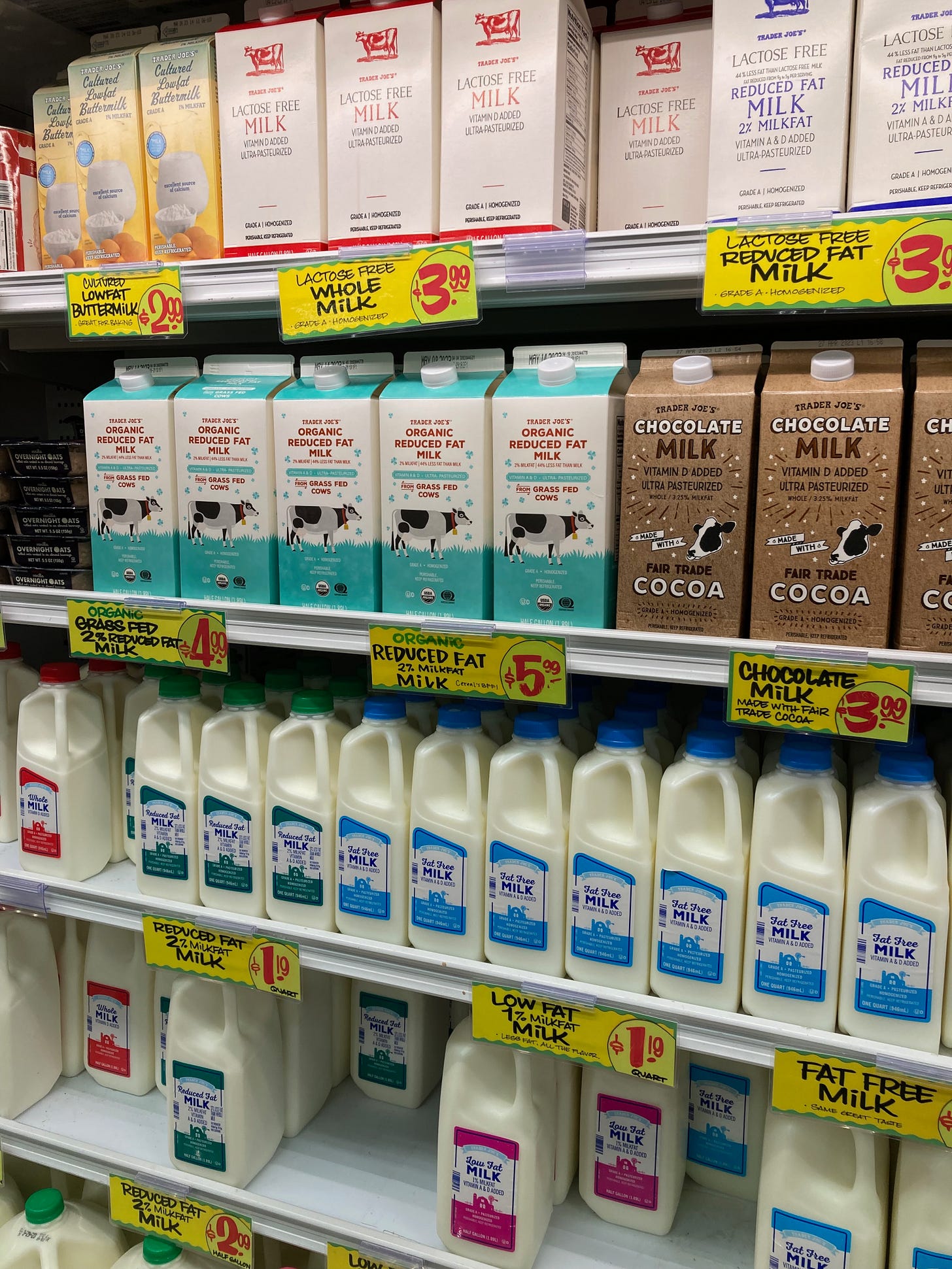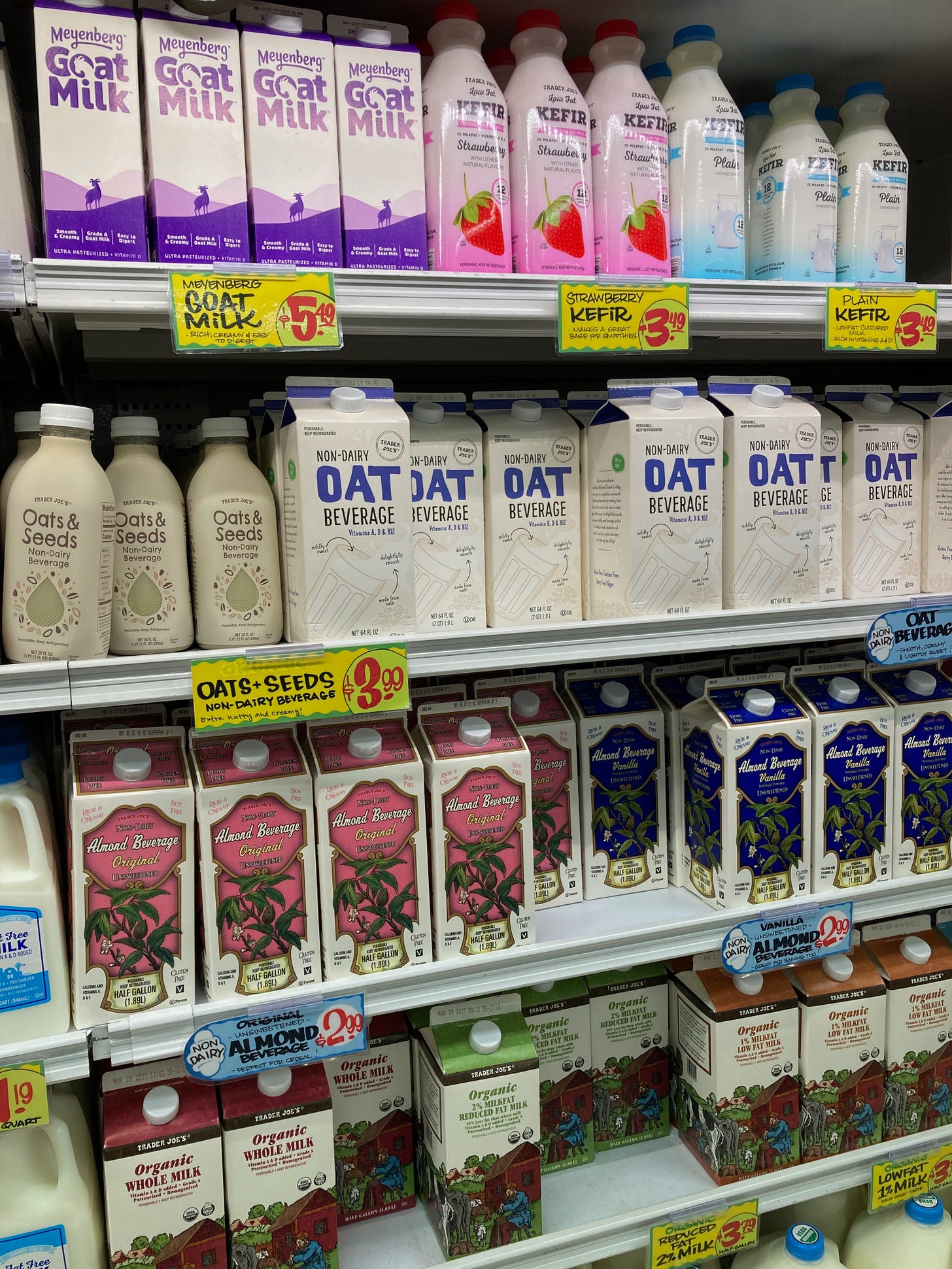My mother detested milk. She never drank a drop, at least not willingly, not even in her morning coffee; she said milk disgusted her—although she loved ice cream and what we used to call store cheese, a firm, locally made cheddar, and neither of these milk products bothered her at all. Was she lactose intolerant? Quite probably.
It may come as a surprise to many North Americans, but the ability as adults to process the lactose in milk is not at all common. Lactose is digested through the work of a naturally occurring enzyme in the body called lactase; the majority of humans, as they mature, stop producing that enzyme. It’s a gradual process that begins once they’re weaned and is usually complete by puberty. After that, fresh milk tends to make them feel nauseous, bloated, uncomfortable. The condition is called lactase deficiency, and it’s altogether common in people of Mediterranean, Asian, indigenous American, and African heritage (which is to say, most of the world), while among Northern Europeans and their descendants, lactase, and with it the ability to digest lactose, persists into adulthood. If she was indeed lactose intolerant, my mother was unusual within her own culture but she made common cause with millions of adults around the world who almost never consume fresh milk apart from perhaps a small amount in their coffee or tea.
Anne Mendelson explains this in her brilliant new book, Spoiled: The Myth of Milk as Superfood (Columbia), although, as she said in an email exchange with me earlier this week: “I do hope people don’t get the idea that the book is a history of lactose intolerance!”
And it’s not. It is really a history of our human relationship to the milk of nonhuman mammals, cows, sheep, goats, buffalo, and also horses, camels, reindeer, and a few other creatures who produce milk to feed their young, which is pretty much the definition of a mammal. Mendelson touched on this subject to a degree in an earlier book, titled simply Milk (Knopf, 2008); this time she goes deeply into the idea (the myth, as she puts it in her subtitle) that milk, especially fresh, liquid, cow’s milk, carries special vital, health-giving properties. The Dietary Guidelines for Americans actually recommend three full glasses of milk daily as a source of calcium, protein, vitamins, and phosphorus, among others. Actually, “fresh” is the wrong adjective, because the pasteurized, homogenized, chilled white liquid available in half a dozen permutations in your supermarket dairy cooler (whole, skim, 1% fat, 2% fat, chocolate-flavored, lactose-free, et al.) is one of the most highly processed items in the average American grocery cart. It has to be in order to make it safe to consume.
And how does the rest of the world, the wide world of the lactase deficient, consume milk? Fermented to some degree—as yogurt, labneh, buttermilk, clabber, sour cream, koumiss (fermented mare’s milk), kefir, and cheeses of various kinds. What makes these safe for the lactase deficient is the fermenting process which converts the milk’s lactose into lactic acid, making it digestible.
So milk is indeed good for you, just not necessarily in its “fresh” liquid form. Not for most people. Indeed, the lactase that allows fresh milk to be digested is characteristic of a very small group of people, mostly from or descended from dairying cultures of northern Europe and the British Isles.
Mendelson’s book tells the story of how fresh cow’s milk became the be-all and end-all of a healthy diet for Americans, especially for American children, and how Americans and others promoted that idea on an international scale, blithely unaware that most of the people on whom they were pushing this civilizing concept were incapable of appreciating it. The effort is ongoing and so persistent that, as Mendelson details, the Chinese government now inexplicably promotes its own milk production and milk drinking, oblivious to the fact that Chinese historically and physiologically have been lactase deficient and have got along just fine, thank you very much. So determined are the Chinese proponents of drinking fresh milk as a way to improve Chinese health outcomes that they are even experimenting with genetic modification to create cows that produce lactose-free milk “naturally.”
How is it, she asks, that we have bought into this mistaken idea?
Much of the blame can be put squarely on the shoulders of the powerful dairy industry, allied with the Federal government and state governments to promote the consumption of “fresh” milk. It’s a movement that has been growing over the last century and a half but the result, which Mendelson also describes in meticulous detail, is painful if ironic. Milk consumption has actually declined almost precipitously in recent decades, hitting an all-time low in 2021 of 16 gallons per person (USDA statistics). At the same time, milk production has escalated, helped along by Federal and state programs and subsidies that promote what we might call Big Milk, with enormous dairy farms (a herd of 300 animals, Mendelson says, is now considered small) of cows that individually produce ever greater quantities of milk. We Americans are awash in a sea of milk that fewer and fewer of us wish to consume. Finding a market for the excess requires constant creativity.
We who are concerned about responsibility and fairness in our food systems talk a lot about food waste, as if individual cooks peeling too many layers off the onion or discarding carrot tops instead of adding them to the stock pot, are the source of the $218 billion worth of food that Americans are said to waste in the course of a year. But what about all that milk?
Yes, but don’t we need milk for the calcium it provides? When I was first writing about the Mediterranean diet, working with the Harvard School of Public Health (now the Harvard T. H. Chan School of Public Health), the Harvard experts were concerned about what they perceived as the lack of calcium in the traditional diets we were exploring. Ah, but they eat a lot of cheese, they suggested. Well, no, not really. A tablespoon of grated parmigiano atop a bowl of pasta doesn’t count as a lot, not compared to the three daily glasses of milk recommended for Americans. Ok, so where is the osteoporosis then? That condition of dangerously fragile, brittle bones actually is found primarily in northern European milk-drinking populations, especially among women, precisely among cultures that experience widespread lactase persistence in adulthood. The reasons and the relationships between these two phenomena are still not really clear.
I hope I haven’t made Mendelson’s book sound dry and uninviting. It is for the most part the opposite, although I had a few difficulties with some of the science—not, I hasten to add, because of obfuscation on the author’s part, simply because I have a hard time with chemistry in general. Apart from that, the book is full of wonderful characters, startling information, and dramatic pictures. I think I shall never forget the image of the women, immigrants from the Balkans or Turkey or Armenia, who arrived in America with handkerchiefs that had been soaked in a batch of their own precious yogurt culture, then dried and packed in suitcases and market baskets for the long journey; once in their new homes, the handkerchief was soaked in warm milk and the culture was made available to revive the family heirloom, from which the family’s own yogurt could be produced. There is something incredibly heartening in that story.
Chicken Thighs Marinated and Roasted in Spicy, Garlicky Yogurt
Keep reading with a 7-day free trial
Subscribe to On the Kitchen Porch to keep reading this post and get 7 days of free access to the full post archives.






